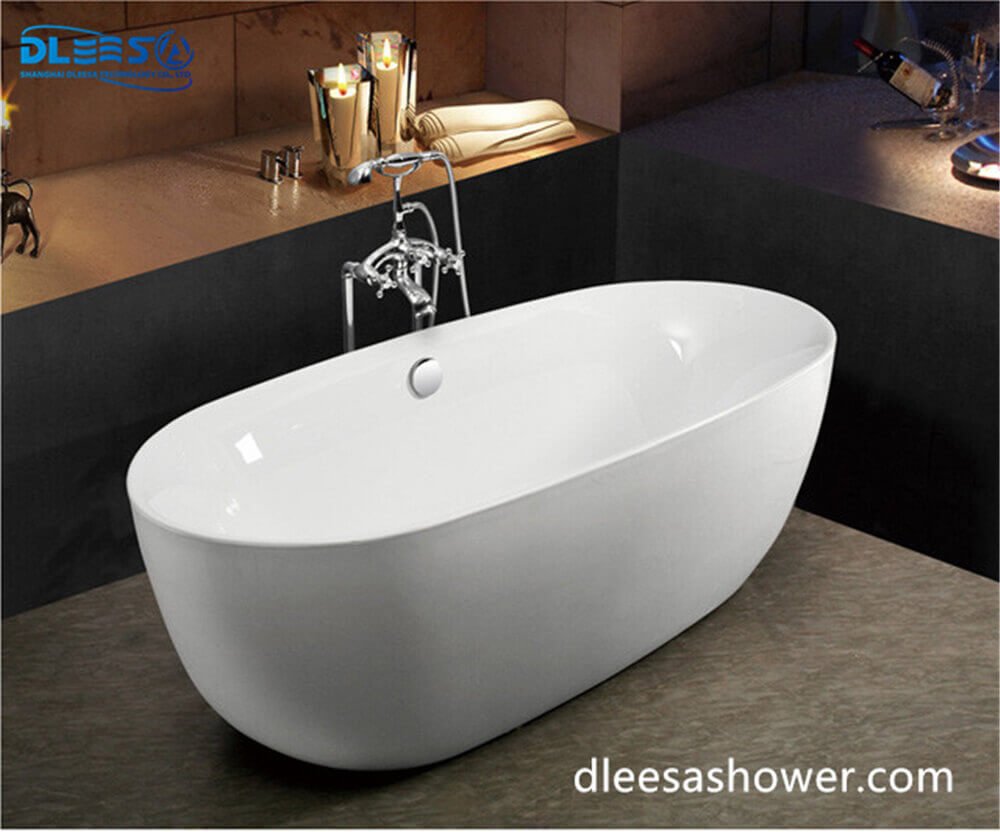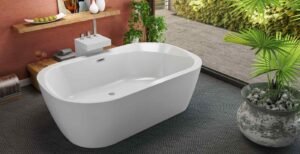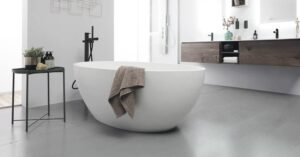Comparing Porcelain And Acrylic Bathtubs
When remodeling your bathroom, a new bathtub can significantly create the room’s tone. Acrylic and porcelain are the foremost popular materials used for bathtubs today. But which one is best? We’ve researched both bathtub materials, and we’ll answer this question for you in this post.
The most significant difference between porcelain and acrylic bathtubs is their weight. Porcelain may be a much harder material than acrylic, and its surface is more resistant to scratches. But, Acrylic tubs are lighter and have a solid fiberglass base. While durable and long-lasting, this finish is often easily scratched by harsh materials and cleaners.
Bathtubs will be the focus of your bathroom, which suggests choosing the best one is worth planning and considering. While acrylic and porcelain bathtubs have some similarities, this can help you to know their differences if you’re stuck between choosing them for your bathroom. Continue reading to be told more about the benefits and downsides of every bathtub material.
Porcelain Tubs
Porcelain tubs are made of either stamped steel or forged iron coated with a layer of porcelain enamel. Before it melts and hardens to be a porcelain tub, it needs to be infused with glass and heated at over 700 degrees Celsius. Overall, porcelain tubs are very durable, and heavy, and if properly maintained, they might last for an extended period of your time.

Advantages of Porcelain Tubs
Durability
Porcelain tubs are known for their durability. Not only can they prevent extremely well against surface scratches, but you’ll be able to repair them yourself if they become damaged. The surface of those tubs is corrosion-resistant, which implies that you just do not have to fret about it rusting–given the coating isn’t damaged.
Easy Cleaning
Another great advantage of porcelain tubs is that they will be easily cleaned with any mild non-abrasive cleaner. You’ll even use hydrogen carbonate as a paste to scrub these tubs regularly. While they’re more proof against scratches than acrylic tubs, it’s advised to avoid abrasive scouring pads and any harsh detergent that will damage the tub’s surface.
Long Lifespan
A porcelain tub can last for more than 20 years. Their solid construction and sturdiness play an enormous role in their lifespan, helping them outlive many other bathtub materials.
Standard Sizes
Since porcelain tubs are in high demand, they are commonly sold in standard bathtub sizes, which are 150 to 75 centimeters. You’ll even have these tubs custom-made to the dimensions of your choice.
Disadvantages of Porcelain Tubs
High Costs
Due to their base material and construction nature, porcelain tubs are typically costlier than acrylic bathtubs. They will also require much more maintenance to keep them from turning dull.
Surface Cracking
Overall, porcelain tubs are very durable. However, when heavy objects are dropped on them, they will be vulnerable to cracks and chips. And if it happens, the enamel coating will split, making the sheeting beneath it more liable to rust.
No Heat Retention
Porcelain tubs tend to show cold to the touch faster than acrylic tubs. However, some models are foam-insulated, which can help significantly counteract any heat loss.
Heavy Material
Because of their steel or forged iron base, porcelain tubs are very heavy to put in and remove from a restroom, especially if the bathtub is oversized. On average, Porcelain tubs can weigh anywhere from 200 to over 500 pounds. And you’d better put additional support on the ground for the bathtub.
Styles and Colors
Traditionally, most porcelain tub will are available in a standard white or off-white color, so there aren’t as many options as other bathtub materials.
Acrylic Tubs
This type of tub is formed from a sheet of acrylic and then laid over a fiberglass base. It’s one of the original durable bathtub materials on the market. The most significant advantage of acrylic tubs is that you are afforded all of the advantages of solid fiberglass with the additional reinforcement of an acrylic coating. Though acrylic could also be vulnerable to some scratching, it’s relatively easy to take care of and might last for over a decade. Let’s discuss a number of the foremost notable pros and cons of acrylic bathtubs.

Advantages of Acrylic Tubs
Durability
Acrylic tubs are unquestionably durable and resilient. They even have a naturally non-porous surface, which implies that they’ll not absorb water, extending their lifespan. They also blockage fairly well to heavy impact and are less likely to crack or chip than porcelain.
Lightweight
Since these tubs’ bases are fiberglass products, you will find that acrylic tubs are lighter than other bathtub materials available today. For homes with multiple floors, acrylic tubs are easier to put in and take away because of their lightweight materials.
Low Cost
Acrylic bathtubs are one of the easily affordable bathtub options on the market. Their flexible price point makes them an attractive option for homeowners and keeps them in demand. Though they will be dearer than other fiberglass tubs, they’re still reasonably affordable, especially compared to other bathtub materials like porcelain, cast iron, or steel.
Styles and Colors
Acrylic bathtubs are available in various sizes, shapes, and styles. You’ll find that almost all bathtubs are available in either white, off-white, or beige. However, you’ll find specialty bathtub stores that supply more color options.
Non-porous Surface
The acrylic tubs can offer excellent heat-retention capabilities because of their non-porous surface. It also means their solid surface won’t become prone to mold, mildew, or rust from everyday wear and tear.
Disadvantages Of Acrylic Tubs
Scratches Easily
Due to the tubs being extremely durable, one of the acrylic tub’s downsides is that their surface can easily scratch. So it is crucial to use mild cleaners and delicate cleaning tools to maintain the tub.
Lower Lifespan
On average, if the acrylic tubs are maintained well, they can last anywhere from 10 to 15 years. However, you will not worry about losing their luster or warping because the years fade. They may, however, turn a touch dull or develop yellow spots from H2O and personal care products.
What Tub Features Do You Want?
Just like finding a partner, you rarely find a bathtub that meets all the criteria. But it’s all about choosing the best bathtub material for you, so it takes a little time to decide what your most essential qualities are uncompromising. This question will make the decision easier, especially if you rely on only two options acrylic or porcelain.
Which Is Easier To Install?
Heavy bathtubs are challenging to handle. Especially true if you have a bathroom on the second floor. So I can say that a porcelain tub is more challenging to install than acrylic since it is heavier.
How Much Do Weigh Do Have Porcelain-Enameled Cast Iron Bathtubs?
Porcelain enamel cast iron tubs are arguably the most difficult of the three materials we focus on in this article. It is due to their weight. These cast iron core tabs weigh between 300 and 500 pounds. And it’s not just about bringing the tub where you want to install it.
You may need to incorporate additional support into the bathroom floor. This may be needed to handle the weight of the tub. Depending on the design of your house, you may want to install only a porcelain enamel cast iron tub on the ground floor. Water weight and bathers should be aware of adding weight to the tub when using.
Porcelain enamel cast iron tubs are often claw-foot tubs. If you are interested in claw-foot bathtubs, there is a lot of information in the guide to buying a claw-foot bathtub, including how to calculate the weight of a claw-foot bathtub.
How to tell if a bathtub is porcelain or enamel?
The easiest way to quickly determine if a tub is a porcelain or enamel is to place a magnet in the tub and see if it sticks. The porcelain tub is lined with steel or cast iron. Enameled bathtubs are not. So if the magnet is attached to the tub, it is made of porcelain, not enamel.
How long will an acrylic tub last?
On average, acrylic bathtubs last about 10 to 15 years until they become dull or need to be replaced.
Do acrylic tubs turn yellow?
Acrylic bathtubs can develop yellow stains over time. Dirt results from the accumulation of residues from substances such as soaps, shampoos, and hard water. It may turn yellow if washed with the wrong cleaning solution. The best way to avoid these stains is to clean the tub frequently and avoid polishing cleaners that contain harsh ingredients.
Final Thoughts
Overall, acrylic may be a way more versatile bathtub material than porcelain. It’s arguably better durability and heat retention, and it’s far more flexible in design and magnificence. Maintenance and repair for both materials are about even, and customarily acrylic is cheaper than porcelain, so acrylic is the recommended choice for your bathroom unless you’re married to the classic look.







